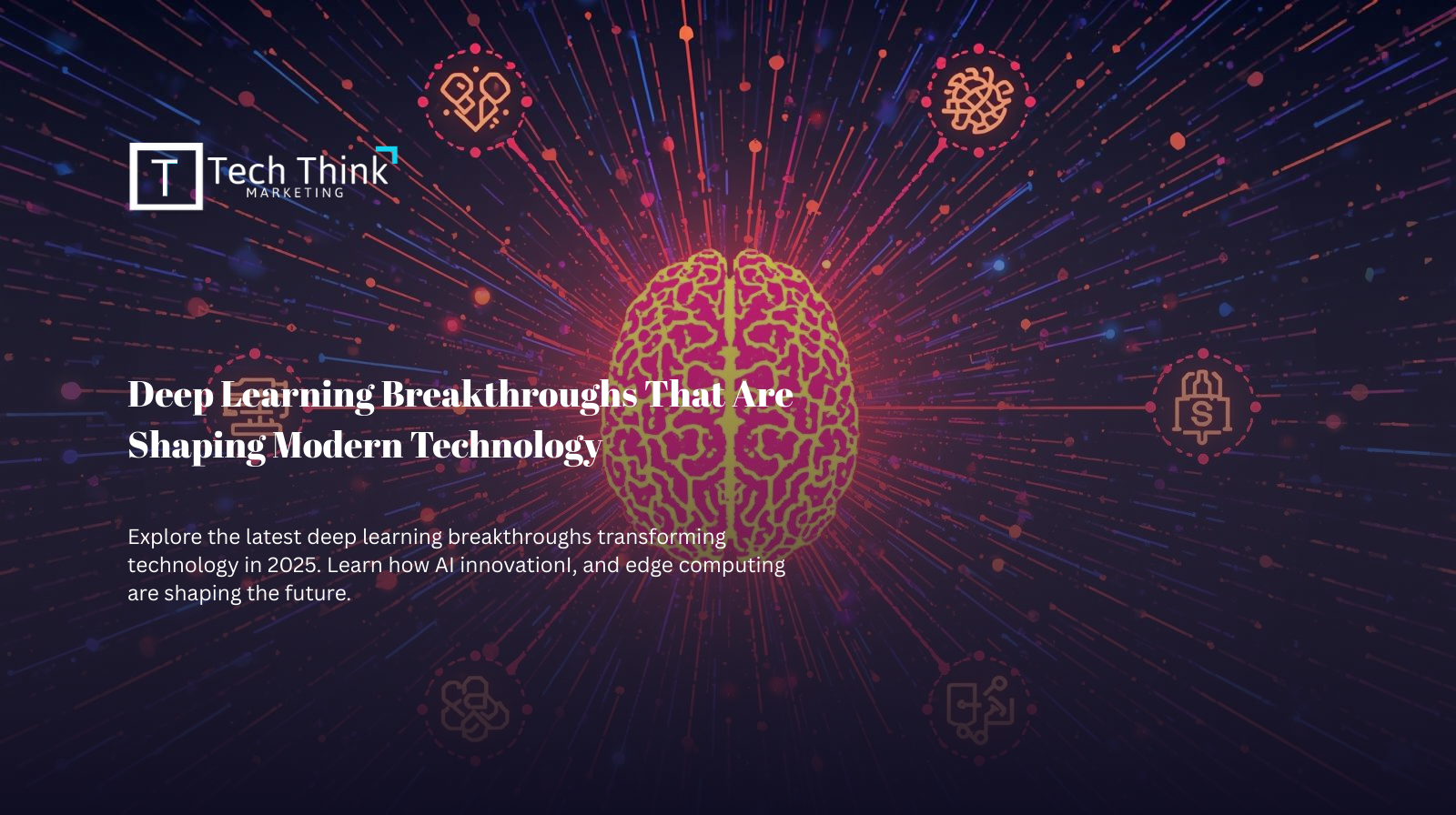Office No. 608, Lunkad Sky Station, Viman Nagar Road, Pune, Maharashtra 411014, India
Phone: +1 213-261-0597
contact@techthinkmarketing.com
Table of Contents
ToggleIntroduction
Deep Learning Breakthroughs Deep learning, a subset of artificial intelligence (AI), has emerged as a transformative force in modern technology. By enabling machines to learn from vast amounts of data, deep learning is powering innovations across industries—from healthcare and finance to automotive and entertainment. In 2025, several breakthroughs in deep learning are shaping the way we live, work, and interact with technology.
Deep Learning Breakthroughs This article explores the key deep learning advancements that are revolutionizing technology, highlighting real-world applications and their impact on society.
What Is Deep Learning?
Deep Learning Breakthroughs Deep learning is a type of machine learning that uses artificial neural networks to simulate human brain function. Unlike traditional algorithms, which rely on clear programming, teachers of patterns in deep learning models data. This ability allows them to perform tasks such as image recognition, natural language treatment (NLP), and future indication analysis with high accuracy.
Important components of deep education include:
- Nerve network—a layer with paired nodes that process data.
- Training Data Set—Huge amounts of marked or non-marked pieces of data used for learning.
- Backpropagation—a method of adjusting the network weight to reduce prediction errors.
- Activation feature—Enable the network to model complex conditions.
Breakthrough 1: Advanced Natural Language Processing (NLP)
Deep Learning Breakthroughs Newer deep learning models, such as transformers and large language models (LLM), have dramatically improved NLP functions. Applications include:
- Chatbots and virtual assistant – AI can naturally understand and answer human questions.
- Text generation and summary can write equipment articles, reports and even codes such as GPT-4 and GPT-5.
- Emotional analysis can analyze customers’ response in real time.
Deep Learning Breakthroughs Effects: Better communication between people and machines so that companies can automate customer service and material production effectively.
Breakthrough 2: Computer Vision and Image Recognition
Deep learning breakthroughs in computer vision are revolutionizing how machines interpret visual data. Convolutional Neural Networks (CNNs) and advanced architectures now power:
- Autonomous vehicles – Cars can detect pedestrians, traffic signs, and other vehicles with high accuracy.
- Medical imaging – AI systems identify tumors, fractures, and anomalies faster than human radiologists.
- Security and surveillance – Facial recognition and anomaly detection enhance safety measures.
Impact: Deep learning is increasing safety, efficiency, and accuracy in industries reliant on visual data.
Breakthrough 3: Generative AI and Creativity
Generative models, like GANs (Generative Adversarial Networks) and diffusion models, are pushing the boundaries of creativity. They can generate:
- Realistic images and videos – Used in entertainment, advertising, and design.
- Synthetic data – Helps train AI models when real data is scarce.
- Music and art – AI-generated compositions and paintings are gaining mainstream attention.
Impact: AI is now a creative partner, opening new possibilities for artists, designers, and marketers.
Breakthrough 4: Reinforcement Learning and Decision Making
Deep Learning Breakthroughs Reinforcement learning (RL) enables machines to learn optimal strategies through trial and error. Breakthroughs in RL are powering:
- Robotics – Robots can perform complex tasks like assembly, packaging, and surgery.
- Gaming AI – Advanced agents outperform humans in games like Go, chess, and real-time strategy games.
- Supply chain optimization – AI optimizes logistics and resource allocation in real-time.
Impact: AI can make autonomous decisions in dynamic environments, improving productivity and efficiency.
Breakthrough 5: Edge AI and Real-Time Processing
Deep Learning Breakthroughs Deep learning is no longer limited to cloud computing. Edge AI enables processing directly on devices like smartphones, IoT devices, and autonomous vehicles. Key advantages:
- Reduced latency for real-time applications.
- Enhanced privacy by keeping sensitive data local.
- Lower dependency on high-speed internet or cloud infrastructure.
Impact: Edge AI makes deep learning more practical, efficient, and secure for everyday applications.
Breakthrough 6: AI in Healthcare and Biotechnology
Deep learning is transforming healthcare and biotechnology through:
- Drug discovery – AI models predict molecule interactions, accelerating new treatments.
- Personalized medicine – AI analyzes patient data to recommend customized therapies.
- Predictive diagnostics – Early detection of diseases improves patient outcomes.
Impact: Deep learning reduces research costs, accelerates medical breakthroughs, and improves patient care.
Breakthrough 7: Explainable AI (XAI)
As AI decisions become more complex, understanding why models make certain predictions is crucial. Explainable AI focuses on:
- Providing transparency in decision-making processes.
- Increasing trust among users and stakeholders.
- Ensuring compliance with regulations in sensitive areas like finance and healthcare.
Impact: Organizations can adopt AI responsibly while maintaining accountability and ethical standards.
Challenges and Considerations
Despite breakthroughs, deep learning faces challenges:
- Data dependency – High-quality, diverse datasets are essential.
- Computational cost – Training large models requires substantial resources.
- Bias and fairness – AI models may reflect existing societal biases.
- Regulatory concerns – Ethical and legal frameworks are still evolving.
Organizations must address these issues to ensure AI benefits society responsibly.
Conclusion
Deep learning breakthroughs are reshaping technology across every sector. From NLP and computer vision to generative AI, reinforcement learning, and edge AI, these advancements are improving efficiency, creativity, and decision-making.
As we move further into 2025 and beyond, businesses and governments must embrace these innovations while addressing ethical, privacy, and regulatory concerns. Deep learning is not just a technological trend—it is a fundamental shift that is shaping the future of modern technology.
By understanding and leveraging these breakthroughs, companies can stay competitive, innovate faster, and deliver smarter solutions to the world.





